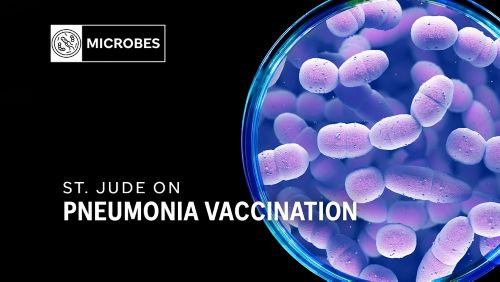St. Jude Family of Websites
Explore our cutting edge research, world-class patient care, career opportunities and more.
St. Jude Children's Research Hospital Home

- Fundraising
St. Jude Family of Websites
Explore our cutting edge research, world-class patient care, career opportunities and more.
St. Jude Children's Research Hospital Home

- Fundraising
Universal pneumonia vaccination is the result of decades of research

Many parents have spent a long night comforting a crying child with an earache. Parents wish for anything to prevent the experience of such pain and protect their kids from infection. This is especially true because the causes of earaches are varied. A worst-case scenario for an earache is that the infection is a precursor to pneumonia that, in rare cases, causes meningitis. While people in high-resource regions, such as the United States, have access to antibiotics to address such a potentially debilitating infection, much of the world does not, with dire consequences.
“Pneumonia is the biggest source of pediatric mortality in the world, period.” said Elaine Tuomanen, MD, St. Jude Department of Host-Microbe Interactions, who has endeavored throughout her career to finding a new way to prevent the disease. “About 22% of all childhood deaths globally, between one and five years of age, are due to pneumonia. Over 70% of the pneumococcus-based infections are preventable, but the current vaccines aren’t flexible enough to cover them.” With millions of children affected, even small increases in vaccine protection could represent a large increase in childhood survival, as well as a decrease in pediatric morbidity, across the world.
Discovering CpbA as a new target for a universal pneumonia vaccine
Pneumococcus is one of three bacterial families that cause pneumonia in children. This family alone has about 100 different strains. Each strain has a slightly different sugar on its surface, which modern vaccines target. However, conventional vaccines can only target a maximum of about 25 sugars, leaving most pneumococcal strains unaddressed. Early in Tuomanen’s career, she decided that there must be a better approach to vaccinating against pneumococcus.

Elaine Tuomanen, MD, made seminal contributions to the creation of a universal vaccine for pneumonia – the biggest source of pediatric mortality worldwide.
“We set out to find if there was something in common among those 100 types that we could target,” Tuomanen said. “We looked at the surface of the bacteria to find the sticky part that attaches onto a human cell. Since the human receptor doesn’t change, we knew that there must be a conserved piece of each bacterium that binds it, which could be a more universal vaccine target.”
She found that the choline-binding protein A (CbpA) was the primary way pneumococcus bound to human lung cells, published in Cell. The outer surface of each bacterium is coated in CbpA, allowing it to stick on cells with the human receptor.
“CbpA proteins are perfectly placed on the surface to be able to make a bridge between the bacteria and the lung,” Tuomanen explained. “They go after this nonspecific and universal receptor on many different cells to get their first opportunity to attach and begin an invasive process. That's where we think we could stop a lot of diseases.”
Making a universal pneumonia vaccine starts with CbpA’s vulnerabilities
Pneumococcus’ vulnerability is in its reliance on CbpA. A collaboration with Richard Kriwacki, PhD, St. Jude Department of Structural Biology, solved the complete structure of CbpA in The EMBO Journal. Researchers then used that information to find a good vaccine target on the protein. The structure showed CbpA contains two conserved regions of about 15 peptides that are required to bind to human cells.
“We found this massive protein has vulnerabilities in just these two tiny spots,” Tuomanen said. Therefore, she wanted to raise an immune response against those small regions, common to all pneumococcal strains and the additional two pneumonia-causing bacterial families. The regions of a protein that immune cells respond to are called epitopes. In addition to the two attachment epitopes, she wanted to also target the pneumococcal toxin, the bacterial protein that causes disease in humans. The challenge was figuring out how to combine three different components in a vaccine suitable for production. The answer was clever biochemical engineering.
“We took the toxin, removed its ability to make you sick and then added those two conserved epitopes from CbpA in a fusion protein. That, in theory, would be a universal vaccine,” Tuomanen said. “We designed it to maintain each structure so that the pieces still do what they're supposed to do when they're put together into this one bigger protein. That’s important, as the fusion protein is much easier to manufacture than either the full CbpA or toxin, minimizing downstream difficulties.”
In early model systems, the fusion protein showed great promise as a universal vaccine in The Journal of Infectious Diseases. This included both cellular and mouse models. When four other independent labs used the fusion protein as a vaccine in their separate models, they also reported improved protection, increasing the confidence that the vaccine worked as intended, published in Clinical and Vaccine Immunology. With those results, the fusion protein was ready to begin the long journey to clinical use.
Translating the pneumonia fusion protein into a clinical vaccine
Though the vaccine showed promise, it still had a long way to go to be ready for use in patients. In advance of this, Tuomanen enlisted the St. Jude Good Manufacturing Practice (GMP) facility early in the process. The GMP is tasked with making products for clinical trials. It houses a high-quality and highly regulated set of equipment and personnel dedicated to making pharmaceutical-grade materials. By including the GMP early on, Tuomanen guaranteed that the fusion protein could be scaled from the batch sizes needed to test in mice to those needed for a clinical trial, at the quality level required for human use. She was one of the advocates of the GMP’s creation, as it did not exist when she started her research. The GMP made extending her research from the lab bench to the bedside possible at St. Jude.
“If you want to build a pipeline for innovation and new products to be tested in children, then you have to take it farther than just the bench,” Tuomanen said. “There’s no company out there to help you to do it. So having our own GMP facility and then being able to go ahead and test novel drugs, vaccines and other products is amazing.”
Based on the positive results and promising production approach, Matrivax, a small pharmaceutical company, licensed the vaccine. The company launched a phase 1 clinical trial in 2023, to assess safety and tolerability. When asked if 25 years ago, Tuomanen expected that her research would lead to today’s vaccine, she responded with humility that masks the genius of the work, “Well, I thought it was the obvious approach.” Her approach has been almost singular, with most other work in the field still focusing on optimizing sugar-based vaccines.
As the project continues its path towards translation into the clinic, her journey has been emotional, especially when handing off the vaccine to a pharmaceutical company. Such handoffs are a necessary step to get the vaccine out of academia and into the world protecting children from disease.
“I remember the day that they said we had our first volunteer come in and receive the vaccine,” Tuomanen said. “I couldn't have imagined that working on something for 20 years, and then finally giving it away to a company and letting them try it, would feel so good. It's almost like I'm giving away my baby. But they have shown the commitment that is needed.”
“So, at first, I was afraid, and then I was thrilled,” Tuomanen concluded. “There are so many kids still at risk, but now the fact that we are finally testing the vaccine in people gives me hope we can soon protect children around the world.”






